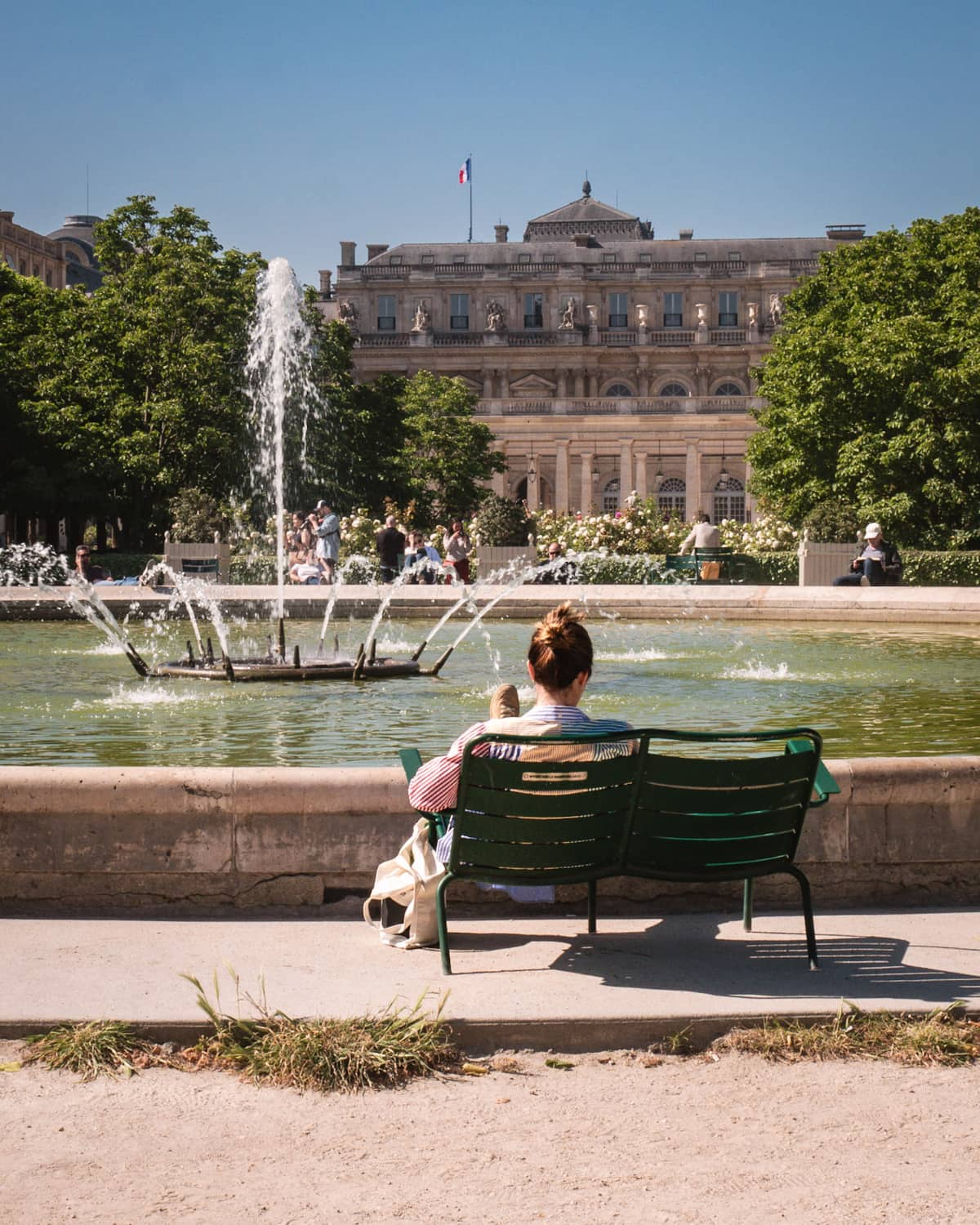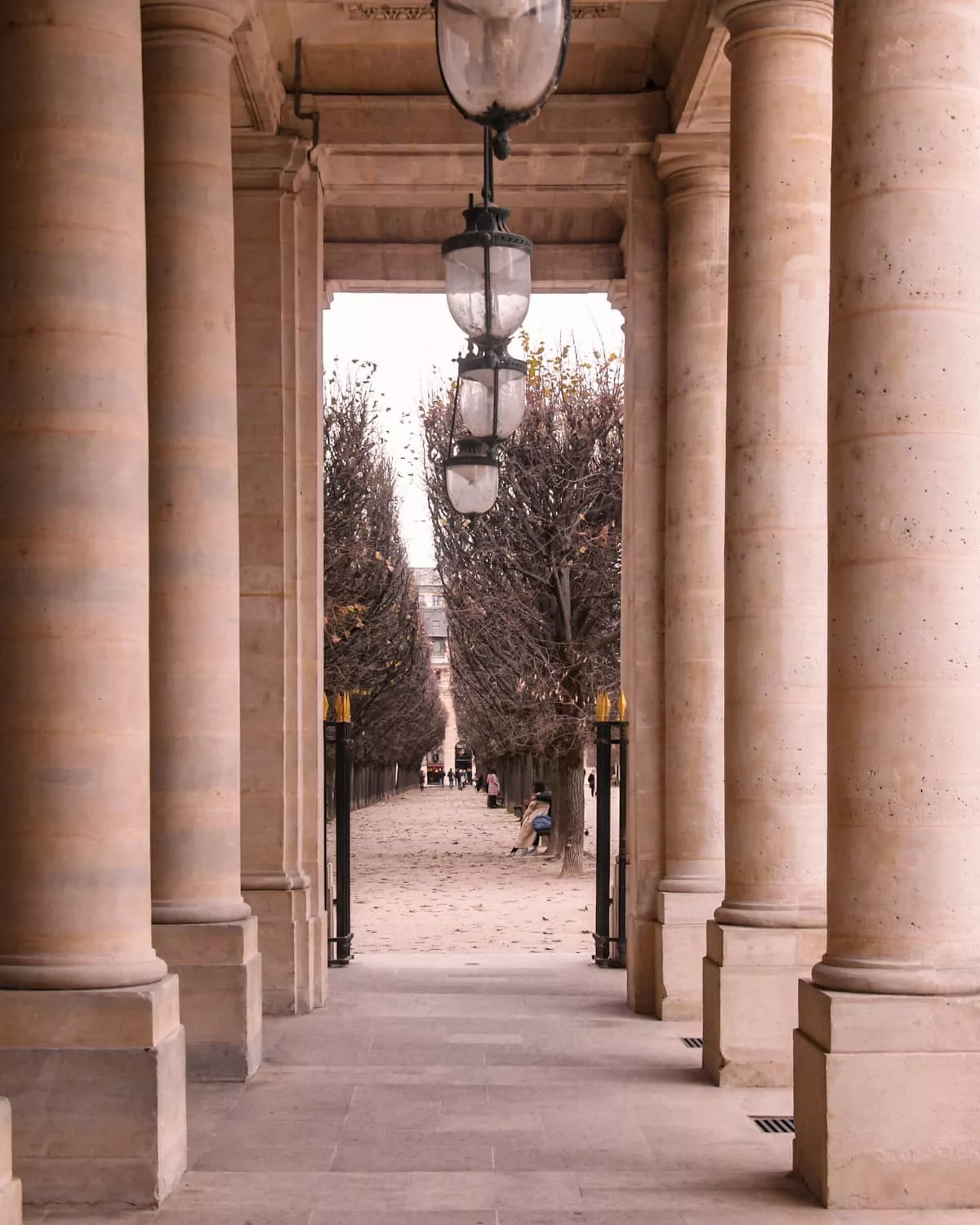Le Jardin du Palais Royal or the Royal Gardens of Paris is an idyllic green oasis away from the buzz of the city of lights. With its walkways lined with green benches, fountains, lawn beds dotted with statues and magnolias, and avenues of chestnut and lime trees, Jardin du Palais Royal manages to create a feeling of quiet intimacy, while being in the heart of Paris.
Jardin du Palais Royal is a remarkable combination of art, architecture and urban nature. It is just a couple of minutes away from the Louvre and makes for a great stop before proceeding onto another Paris hidden gem, Galerie Vivienne.
The first visually impactful element of this Paris gem, is the symmetry. All you see around you are long leading lines. Neatly trimmed trees line the garden pathways, while the gorgeous classical facades of Palais Royale overlook the garden on all sides. When the sun shines, the way the trees and columns filter the light, casts the most beautiful shadows. While the sound of the water and breeze help dull away sharp city noises.

History of Palais Royal and the garden
The Palais-Royal and its garden is located in Domaine National du Palais-Royal. It was created in 1629 at the request of Cardinal Richelieu, the ‘Palais-Cardinal.’ Later, it was Louis XIII who inherited it. He transformed this space into a royal palace, earmarking it as a residence for the royal family.
The gardens of Palais-Royal started taking shape around 1730, as the royal gardeners started renovating the old space. The site became popular with Paris locals, particularly writers, dreamers and strollers or flaneûrs as the French say, who would come here to converse or just while away their time in it’s delicious serenity. Later, in 1781, royal architect Victor Louis set about designing the gardens in the form that we know now.
The sprawling rectangular Jardin du Palais Royal was later outlined on three sides by the addition of elegant arcades. These are Galerie de Valois, Galerie de Montpensier and Galerie Beaujolais. The multitude of stories they contain, are both fascinating and colourful. For example, once upon a time, the arcade used to house the Cabinet des Figures de Cires or Cabinet of Wax Figures (1785) owned by Swiss Curtius. His niece went on to become the famous Madame Tussaud, who is well known today for her eponymous wax museum. Even today, these arcades house galleries, design shops and restaurants.

On the fourth side of the square garden, is Daniel Buren’s art installation Les Deux Plateaux, the black-and-white striped columns which have now become completely social-media famous. Behind the courtyard, the Montpensier and Valois wings house the Constitutional Council, the highest constitutional authority in France and the French Ministry of Culture.
From parties, balls, literary and scientific conferences, and important political meals, to tableaux vivants or living picture where people pose to create static scenes like in a painting, this garden has seen it all through the centuries. The Jardin du Palais Royal is one France’s protected gardens and is considered part of its national heritage. In fact, the Ministry of Culture has bestowed the label of ‘Jardin Remarquable’ or a remarkable or exceptional garden on Jardin du Palais Royal.

Royal Palace Garden has an important Paris time-piece
Not many people know that the Jardin du Palais Royal also contains one of the most important sundials in the history of Paris. Called, le canon méridien, the time-piece is in the form of a tiny golden cannon atop a concrete mount. You can find it in one of the lawn-beds in the centre of the garden.
Before automatic and accurate watches became a standard thing, people would count on the state to tell them the time and hour of the day. This was so they could set the correct time i.e the Paris meridian time. In Paris, the tiny little cannon in the middle of the Palais Royal was integral in helping people do this. From 1786 and until 1911, Parisians regulated their watches and clocks using the cannon in the Palais Royal Garden!
Sieur Rousseau, a watchmaker with a shop at the Beaujolais gallery, designed this contraption. The way the equipment works is when the sun shines up in the sky at high noon, a magnifying glass leads the fuse inside the cannon to ignite and fire. Thereby letting people know it is noon.

From 1911, France switched to Greenwich Mean Time, and since then the cannon has remained unused. However, the French state still puts it to work every now and then, in order to mark important occasions. It thunders on days such as anniversary of the Liberation of Paris (August 25), European Heritage Days (3rd weekend of September) and the national holiday (July 14).
Unfortunately, unknown miscreants stole the original cannon in 1998. The one we see now is a replica.
Expositions and art in Jardin du Palais Royal
Along with nature, the Palais Royal Garden is a great place to enjoy art and culture. Daniel Buren’s Les Deux Plateaux, also called Colonnes de Buren or Buren’s columns, stands as the most recognised work of art here in the inner courtyard or Cour d’Honneur of Palais Royal. These are black and white candy-striped columns of various lengths that seemingly jut out from the concrete floor in symmetrical lines. The effect is a mesmerising installation that plays with the viewer’s perception of visuals and space.
Le Palais Royal also hosts ephemeral art installations. Just last autumn, the Jardin du Palais Royal hosted master glassmaker Emmanuel Barrois’ installation called ‘Réflexions.’ This was a 15-metre-high glass structure that sparkled with the iridescent beauty of interwoven glass prisms. Apart from its quiet, contemplative splendour, this installation was also a representation of cutting edge technical prowess by the team that included architects such as Rudy Ricciotti, Kengo Kuma and Christian de Portzamparc.

Apart from these celebrated works of art, I love spotting the tiny artful details strewn everywhere in the garden. Besides the statues in the lawn beds, beautiful quotes are scribbled on the benches. These add oodles of intellectual charm.
I especially love the chairs that come in twos. These are twin chairs fused such that they sit facing each other. This means people using them have to sit face-to-face, and likely, engage in conversations.
The Jardin du Palais Royal also has a Wallace Fountain. Sir Richard Wallace financed the installations of these potable water fountains in 1872. Today, these stand as a testament to the history of evolution of Paris, and have great historical and cultural significance. You can locate Wallace Fountains in Paris here.
Different facet of Paris in every season
Jardin du Palais Royale one of the best locations to experience different moods of Paris in different seasons. In early spring, the garden provides visitors a shockingly beautiful sight. Its magnolia trees are in full magenta-pink bloom between the end of March and beginning of April.
We have renowned landscaper Mark Rudkin to thank for the incredible show of these magnolia blooms . He managed a series of major renovations in the garden of the Royal Palace in 1992. Along with 16 magnolia trees, Rudkin also added rows of dahlias and roses, giving the space an ethereal feel. These add a touch of wild pastoral charm to the otherwise chic and elegant garden.

Blooming magnolias and dahlias are followed by the season of blooming roses in spring. In summer, the gardens becomes the chosen hub for people to laze around. On any given day, you are likely to find droves of Parisians eating their lunch in the tree lined benches, or taking lazy naps by the sound of the fountain. In winter, the garden becomes the perfect place for catching some sun rays.
One of my favourite seasons to observe here is autumn. The green chestnut trees in the garden turns into a beautiful rows of gold and yellow. The autumn light and colours transform this garden from being beautiful and elegant to having a mysterious edge. Don’t pass up on a walk through the canopy of autumn foliage here at Jardin du Palais Royal if you are in Paris between October and November. The fact that the garden also gets quieter adds to its air of autumn melancholia.
Perfect place to read, picnic or have a photoshoot
Jardin du Palais Royal is also a pleasant place to picnic or read thanks to the number of benches that line its walkways. If you fancy a coffee, Café Kitsuné situated in one of the arcades has grown to a cult status. I usually like to get a cuppa to go, and then slowly saunter around the garden.
Sadly, I have not yet tried eating in one of the restaurants around the garden.Usually, my friends and I pick up lunch from neighbouring restaurants, and bring our food and drinks here to eat. If you do the same, just be cognisant of the place and surroundings and clean up after yourself.

Jardin du Palais Royal is the perfect place to go for a photo walk or to have a photoshoot. The gorgeous lawns, walk ways, the fountains and the symmetrical columns make it a perfect set for photographs. The fact that the garden also features in Netflix’s hit show Emily in Paris might be motivation enough for some to try it.
While here, embrace the slow life, sit for a while and revel in the serenity of Le Jardin du Palais Royal. Most of all, connect to the moments of sheer beauty strewn everywhere.
Additional information
Address: Jardin du Palais Royal, 8 Rue de Montpensier, 75001 Paris
Entry fee: Free
Opening hours:
1 October- 31 March: 8:00- 20:30
1 April- 30 September: 8:30- 22:30

